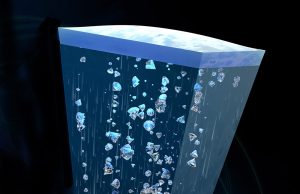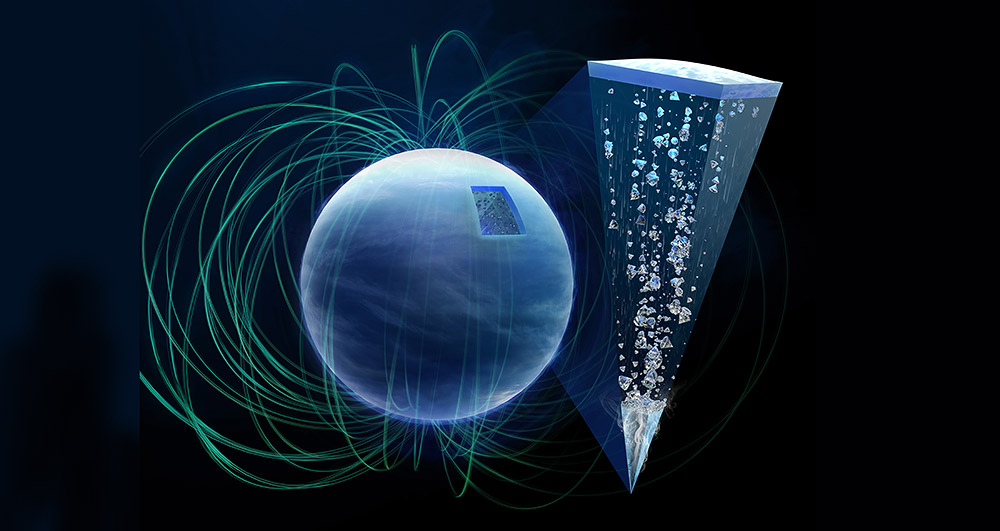Rain of precious planets: Diamonds fall inside the icy planets Uranus and Neptune, as an experiment has now confirmed. Accordingly, the pressure and temperature in the two ice giants are sufficient to split hydrocarbons and compress carbon into diamond crystals. The crystals sink toward the planet's core, and could explain why Uranus and Neptune are warmer than they should be. Their unusual multipole magnetic field could also be due to diamond rain, the team reports in “Nature Astronomy.”
Uranus and Neptune are strange icy planets: they are the only planets in the solar system that have a quadrupole magnetic field, and they are neither rocky planets nor gas giants. Instead, beneath its dense gaseous atmosphere is a blanket of water ice, ammonia, rock fragments and many hydrocarbons – including exotic compounds that do not exist on Earth. They arise because there is greater heat and pressure in the interior of the two planets than in the depths of our much smaller universe.
From methane and co to diamonds
Now it turns out that Uranus and Neptune have real treasure inside: they may be raining diamonds, an experiment has now confirmed. A team led by Mungo Frost of the SLAC National Accelerator Laboratory in California studied the conditions under which hydrocarbons decompose in the interiors of the two icy planets. Previous studies had already indicated that diamonds could then be formed from the released carbon.
But how much pressure and heat are necessary? Are the conditions inside Uranus and Neptune sufficient? “Until now, there has been a lot of disagreement about this,” the researchers explain. Experiments with methane shock laser compression have shown that diamonds only form at pressures greater than 140 GPa and temperatures up to 3,700 degrees. However, other experiments have found much lower values, which some researchers believe may be caused by contamination by metal laser absorbers.
High pressure experience as an ice giant counterpart
To clarify this discrepancy, Frost and his team conducted new experiments with the European X-ray laser XFEL. To do this, they subjected the hydrocarbon polystyrene, which is a suitable model – a common basis for foam and Styrofoam – to increasing pressures in a diamond stamping cell. At the same time, they heated the sample using short X-ray laser pulses and observed the structure of the material using X-ray scattering. To avoid metal contamination, they used non-reactive gold as a laser absorber.
The result: the hydrocarbon turns into diamonds at a temperature of about 2300 degrees and a pressure of 19 to 27 gigapascals. After about 30 microseconds, very fine diamond powder is created. “After about 40 microseconds, larger diamond crystals begin to form, as can be seen from the clearly visible spots in the scattering pattern,” Frost and his team say. In general, these diamonds are created at lower pressure and lower heat than previously assumed.

Diamond rain affects heat and magnetic fields
For Uranus and Neptune, this means: “Conditions already exist in the upper layers of their mantle, in which we observed diamond formation,” Frost and his colleagues report. Inside these two ice giants are diamonds that sink deep into them, raining down diamond crystals.
This diamond rain has an effect on the thermal balance and perhaps also on the ice giant's magnetic field. Reason 1: When hydrocarbons are broken down into diamonds, this releases heat. “Shallow diamond formation depth also causes it to sink and generate more potential heat,” the researchers explained. This could explain why the planets are relatively warm despite their distance from the Sun.
Second effect: Diamond rain also pulls gas and ice into the depths and can thus cause convection currents in the mantle of the icy planets. Since the conducting particles also start moving, they can contribute to the unusual magnetic fields of Neptune and Uranus. “Convection and the resulting dynamo activity are the origin of the complex, multipole magnetic fields of ice giants,” Frost and his team wrote.
Diamonds are also found in the minor exoplanets of Neptune
The new findings also have significance for exoplanets and other celestial bodies: if hydrocarbons turn into diamonds at the low pressures and temperatures determined now, this may also happen on smaller celestial bodies than previously thought. “Although the number of icy moons in the solar system is 10 gigapascals greater, several exoplanets whose densities match the ice-rich composition and whose sizes lie between Earth and Neptune have already been discovered,” the team explains.
This means that, for example, there could also be diamond rain within the relatively common subplanets. “These small Neptunes are of particular interest because of their abundance and abundance of water,” Frost and his colleagues wrote. “If diamonds are also formed in them, this could affect their geological dynamics, atmospheric composition and planetary evolution.” (Natural Astronomy, 2024; doi: 10.1038/s41550-023-02147-x)
Source: Nature, European XFEL
January 11, 2024 – Nadia Podbrigar

“Prone to fits of apathy. Zombie ninja. Entrepreneur. Organizer. Evil travel aficionado. Coffee practitioner. Beer lover.”







More Stories
Resident Evil 9: Release may have been delayed internally, insiders say
Roberts Radio: New DAB+/Internet radio combination Stream 67L
The next change to WhatsApp – the first details about the new functionality known